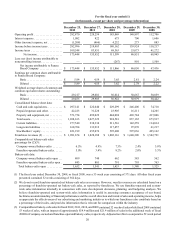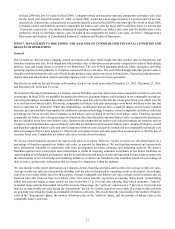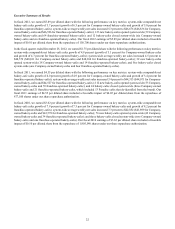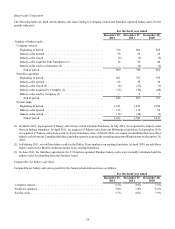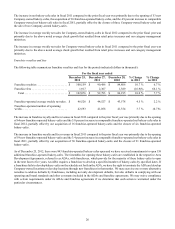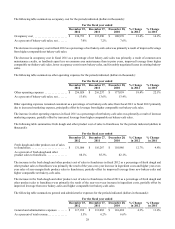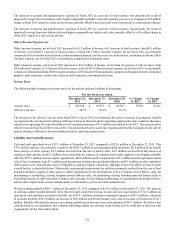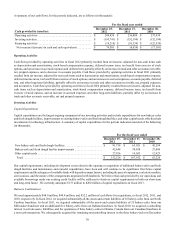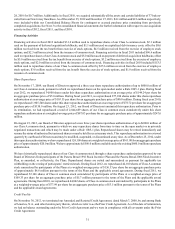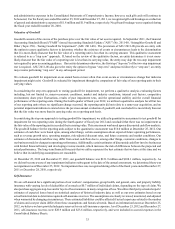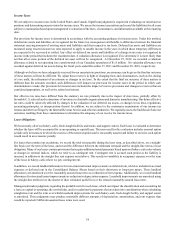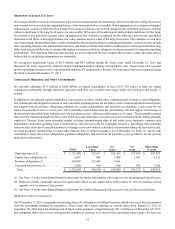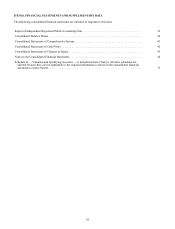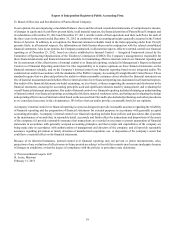Panera Bread 2012 Annual Report Download - page 37
Download and view the complete annual report
Please find page 37 of the 2012 Panera Bread annual report below. You can navigate through the pages in the report by either clicking on the pages listed below, or by using the keyword search tool below to find specific information within the annual report.
29
The decrease in general and administrative expenses in fiscal 2012 as a percent of total revenues was primarily the result of
improved leverage from new bakery-cafes, higher comparable net bakery-cafe sales, and the year-over-year impact of a $5 million
charge in fiscal 2011 related to a class action lawsuit, partially offset by increased year-over-year incentive compensation expense.
The decrease in general and administrative expenses in fiscal 2011 as a percent of total revenues was primarily the result of
improved leverage from new bakery-cafes and higher comparable net bakery-cafe sales, partially offset by a $5 million charge in
fiscal 2011 related to a class action lawsuit.
Other (Income) Expense, net
Other (income) expense, net in fiscal 2012 increased to $1.2 million of income, or 0.1 percent of total revenues, from $0.5 million
of income, or less than 0.1 percent of total revenues, in fiscal 2011. Other (income) expense, net for fiscal 2012 was primarily
comprised of the favorable outcome from certain unclaimed property and state sales tax audit matters, and immaterial items. Other
(income) expense, net for fiscal 2011 was primarily comprised of immaterial items.
Other (income) expense, net in fiscal 2011 increased to $0.5 million of income, or less than 0.1 percent of total revenues, from
$4.2 million of expense, or 0.3 percent of total revenues, in fiscal 2010. Other (income) expense, net for fiscal 2011 was primarily
comprised of immaterial items. Other (income) expense, net for fiscal 2010 was primarily comprised of charges related to unclaimed
property audit exposures, certain state sales tax audit exposures, and immaterial items.
Income Taxes
The following table summarizes income taxes for the periods indicated (dollars in thousands):
For the fiscal year ended
December 25,
2012 December 27,
2011 December 28,
2010 % Change
in 2012 % Change
in 2011
Income taxes . . . . . . . . . . . . . . . . . . . . . . . . . . $ 109,548 $ 83,951 $ 68,563 30.5% 22.4%
Effective tax rate. . . . . . . . . . . . . . . . . . . . . . . 38.7% 38.2% 38.1%
The increase in the effective tax rate from fiscal 2011 to fiscal 2012 was primarily driven by a decrease in permanent benefits
recognized in the current period relating to differences between financial and tax reporting requirements and a valuation allowance
related to net operating loss carryforwards of our Canadian operations of $1.8 million recorded in fiscal 2012. The increase in the
effective tax rate from fiscal 2010 to fiscal 2011 was primarily driven by a decrease in permanent benefits recognized in the current
period relating to differences between financial and tax reporting requirements.
Liquidity and Capital Resources
Cash and cash equivalents were $297.1 million at December 25, 2012 compared to $222.6 million at December 27, 2011. This
$74.5 million increase was primarily a result of the $289.5 million of cash generated from operations, $8.6 million of tax benefit
from exercise of stock options, $4.5 million received from the sale of bakery-cafes, $4.5 million received from the exercise of
employee stock options, and $2.5 million of proceeds from the issuance of common stock under employee benefit plans, partially
offset by $152.3 million used on capital expenditures, $48.0 million used for acquisitions, $31.6 million used to repurchase shares
of our Class A common stock, $2.1 million used for payment of deferred acquisition holdbacks, and $1.1 million used for capitalized
debt issuance costs. Our primary source of liquidity is cash provided by operations, although we have the ability to borrow under
a credit facility, as described below. Historically, our principal requirements for cash have primarily resulted from the cost of food
and paper products, employee labor, and our capital expenditures for the development of new Company-owned bakery-cafes, for
maintaining or remodeling existing Company-owned bakery-cafes, for purchasing existing franchise-operated bakery-cafes or
ownership interests in other restaurant or bakery-cafe concepts, for developing, maintaining, or remodeling fresh dough facilities,
and for other capital needs such as enhancements to information systems and other infrastructure.
We had working capital of $201.3 million at December 25, 2012 compared to $114.8 million at December 27, 2011. The increase
in working capital resulted primarily from the previously described increase in cash and cash equivalents of $74.5 million, an
increase in trade and other accounts receivable, net of $31.5 million, an increase in prepaid expenses of $11.0 million, a decrease
in accounts payable of $6.5 million, an increase of $6.0 million in deferred income taxes, and an increase in inventories of $2.7
million. Partially offsetting the increase in working capital was an increase in accrued expenses of $45.7 million. We believe that
cash provided by our operations and available borrowings under our existing credit facility will be sufficient to fund our cash
requirements for the foreseeable future.



